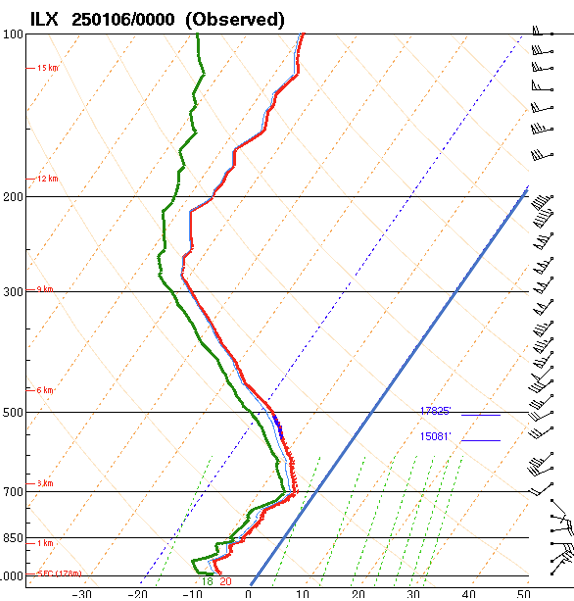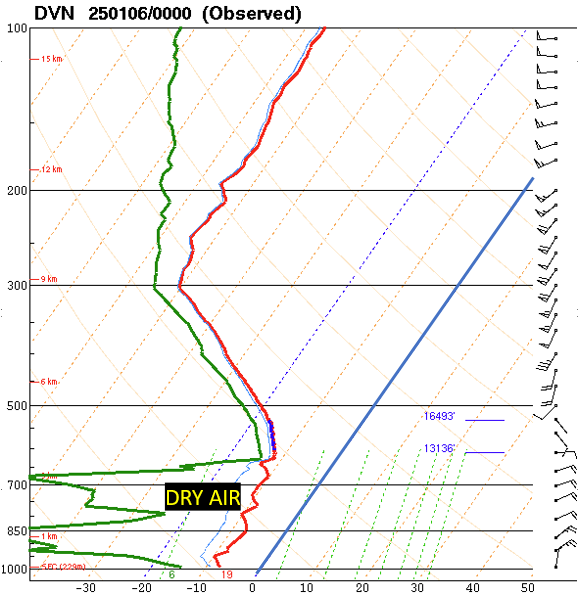January 5-6, 2025
A major winter storm system impacted central Illinois from the morning of January 5th through the morning of January 6th. Snow was the primary precipitation type, although the profile warmed enough to produce some sleet and freezing drizzle south of the I-70 corridor. Snowfall amounts were impressive...with the highest totals of 6 to 10 inches occurring along and south of a Rushville...to Lincoln...to Paris line.
Upper air analysis from the morning of January 5th showed a vigorous short-wave trough over the Central Plains with a strong jet streak (depicted in blue shading on the map below) from Texas northeastward into Missouri. At the same time, a second jet streak was analyzed further northeast from Wisconsin southeastward to the Mid-Atlantic states. With upper divergence focused in the left exit region and the right entrance region of jet streaks, this coupled structure allowed for maximum upper-level divergence and corresponding synoptic lift across Kansas, Missouri, and Illinois.
500MB MAP 6AM CST JANUARY 5
At the surface, a 1002mb low had formed within this area of favorable upper dynamics over Oklahoma...and a significant swath of snow, sleet, and freezing rain was falling across Kansas and Missouri. Further northeast, light snow was beginning to spread into south-central Illinois: however, it was encountering a dry northeasterly boundary layer flow courtesy of a 1040mb high anchored over the Dakotas.
SURFACE MAP 6AM CST JANUARY 5
As the day progressed, the snow gradually spread further northward...but continued to have considerable difficulty fighting the dry inflow from the northeast. In fact, while light to moderate snow was ongoing throughout the day south of the I-74 corridor, locations to the north remained largely dry. The images below show data collected from upper air balloon launches during the early evening of January 5th at Lincoln NWS (left) and Quad Cities NWS (right). The red line depicts the temperature trace throughout the depth of the atmosphere while the green line represents the dewpoint. When these two lines are close together, this indicates areas of saturation. When the two are far apart, this shows where the airmass is dry. Note how the sounding indicates a fully saturated profile in Lincoln, but maintains a significant dry layer from the surface up to about 12,000ft aloft at Quad Cities.
 |
 |
While radar echoes gave the appearance that it was snowing along and north of I-74 throughout the afternoon, the low-level dry layer prevented precipitation from reaching the ground until the atmosphere gradually moistened from the top-down during the evening. Below is a series of radar imagery from January 5th showing how the precipitation evolved. At 6am, an initial surge of very light snow (red oval) had arrived everywhere south of I-74. By midday, the snow had become heavier and more widespread across central Illinois, but note the large precipitation-free area from Peoria to Bloomington. Finally by 6pm, the profile had moistened enough to support the development of light snow or flurries at both Peoria and Bloomington.
RADAR IMAGERY 6AM CST JANUARY 5
RADAR IMAGERY 12PM CST JANUARY 5
RADAR IMAGERY 6PM CST JANUARY 5
Snow was the primary precipitation type with this system: however, as the low approached western Kentucky and temperatures warmed aloft, the snow mixed with and changed to sleet and freezing drizzle south of I-70 during the late afternoon and evening. This mitigated snow accumulations a bit across this area, but also added a thin layer of ice. By mid-evening, the low was centered near Bowling Green, Kentucky and a band of light to moderate snow associated with the trough of warm air aloft (TROWAL) pivoting around the low had developed over the Illinois River Valley. This band shifted eastward overnight, then slowly pushed into Indiana by mid-morning January 6th.
SURFACE MAP 9PM CST JANUARY 5
RADAR IMAGERY 12AM CST JANUARY 6
Once the snow ended, a significant accumulation had occurred across much of central Illinois. Amounts in excess of 6 inches were observed along and south of a Rushville...to Lincoln...to Paris line...with peak totals of 8 to 10 inches in a band from Jacksonville...to Springfield...to Mattoon. As expected, there was a sharp northern cut-off to the snow amounts due to the dry inflow from the northeast. Peoria and Bloomington picked up 1 to 2 inches of snow, while the far northern counties of Stark and Marshall saw only trace amounts.
STORM TOTAL SNOWFALL CST JANUARY 5- 6, 2025